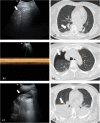Feasibility and efficacy of lung ultrasound to investigate pulmonary complications in patients who developed postoperative Hypoxaemia-a prospective study
- PMID: 32873237
- PMCID: PMC7461251
- DOI: 10.1186/s12871-020-01123-6
Feasibility and efficacy of lung ultrasound to investigate pulmonary complications in patients who developed postoperative Hypoxaemia-a prospective study
Erratum in
-
Correction to: Feasibility and efficacy of lung ultrasound to investigate pulmonary complications in patients who developed postoperative Hypoxaemia-a prospective study.BMC Anesthesiol. 2020 Nov 9;20(1):281. doi: 10.1186/s12871-020-01196-3. BMC Anesthesiol. 2020. PMID: 33167910 Free PMC article.
Abstract
Background: Postoperative pulmonary complications (PPCs) and hypoxaemia are associated with morbidity and mortality. We aimed to evaluate the feasibility and efficacy of lung ultrasound (LUS) to diagnose PPCs in patients suffering from hypoxaemia after general anaesthesia and compare the results to those of thoracic computed tomography (CT).
Methods: Adult patients who received general anaesthesia and suffered from hypoxaemia in the postanaesthesia care unit (PACU) were analysed. Hypoxaemia was defined as an oxygen saturation measured by pulse oximetry (SPO2) less than 92% for more than 30 s under ambient air conditions. LUS was performed by two trained anaesthesiologists once hypoxaemia occurred. After LUS examination, each patient was transported to the radiology department for thoracic CT scan within 1 h before returning to the ward.
Results: From January 2019 to May 2019, 113 patients (61 men) undergoing abdominal surgery (45 patients, 39.8%), video-assisted thoracic surgery (31 patients, 27.4%), major orthopaedic surgery (17 patients, 15.0%), neurosurgery (10 patients, 8.8%) or other surgery (10 patients, 8.8%) were included. CT diagnosed 327 of 1356 lung zones as atelectasis, while LUS revealed atelectasis in 311 of the CT-confirmed zones. Pneumothorax was detected by CT scan in 75 quadrants, 72 of which were detected by LUS. Pleural effusion was diagnosed in 144 zones on CT scan, and LUS detected 131 of these zones. LUS was reliable in diagnosing atelectasis (sensitivity 98.0%, specificity 96.7% and diagnostic accuracy 97.2%), pneumothorax (sensitivity 90.0%, specificity 98.9% and diagnostic accuracy 96.7%) and pleural effusion (sensitivity 92.9%, specificity 96.0% and diagnostic accuracy 95.1%).
Conclusions: Lung ultrasound is feasible, efficient and accurate in diagnosing different aetiologies of postoperative hypoxia in healthy-weight patients in the PACU.
Trial registration: Current Controlled Trials NCT03802175 , 2018/12/05, www.ClinicalTrials.gov.
Keywords: Atelectasis; Lung ultrasound; Pleural effusion; Pneumothorax; Thoracic computed tomography.
Conflict of interest statement
The authors declare that they have no competing interests.
Figures




Similar articles
-
Performance of Lung Ultrasound in Detecting Peri-Operative Atelectasis after General Anesthesia.Ultrasound Med Biol. 2016 Dec;42(12):2775-2784. doi: 10.1016/j.ultrasmedbio.2016.06.010. Epub 2016 Sep 14. Ultrasound Med Biol. 2016. PMID: 27639431
-
Lung ultrasound and diaphragmatic excursion assessment for evaluating perioperative atelectasis and aeration loss during video-assisted thoracic surgery: a feasibility study.Ann Palliat Med. 2020 Jul;9(4):1506-1517. doi: 10.21037/apm-19-595b. Epub 2020 Jul 9. Ann Palliat Med. 2020. PMID: 32648454
-
The accuracy of postoperative, non-invasive Air-Test to diagnose atelectasis in healthy patients after surgery: a prospective, diagnostic pilot study.BMJ Open. 2017 May 29;7(5):e015560. doi: 10.1136/bmjopen-2016-015560. BMJ Open. 2017. PMID: 28554935 Free PMC article.
-
The role of lung ultrasound for detecting atelectasis, consolidation, and/or pneumonia in the adult cardiac surgery population: A scoping review of the literature.Aust Crit Care. 2024 Jan;37(1):193-201. doi: 10.1016/j.aucc.2023.08.002. Epub 2023 Sep 13. Aust Crit Care. 2024. PMID: 37709655
-
Is thoracic ultrasound a viable alternative to conventional imaging in the critical care setting?Br J Anaesth. 2013 Aug;111(2):152-60. doi: 10.1093/bja/aet076. Epub 2013 Apr 12. Br J Anaesth. 2013. PMID: 23585400 Review.
Cited by
-
The 2023 Core Content of advanced emergency medicine ultrasonography.J Am Coll Emerg Physicians Open. 2023 Aug 9;4(4):e13015. doi: 10.1002/emp2.13015. eCollection 2023 Aug. J Am Coll Emerg Physicians Open. 2023. PMID: 37564703 Free PMC article.
-
Effect of recruitment manoeuvres under lung ultrasound-guidance and positive end-expiratory pressure on postoperative atelectasis and hypoxemia in major open upper abdominal surgery: A randomized controlled trial.Heliyon. 2023 Jan 30;9(2):e13348. doi: 10.1016/j.heliyon.2023.e13348. eCollection 2023 Feb. Heliyon. 2023. PMID: 36755592 Free PMC article.
-
Lung ultrasound for evaluating perioperative atelectasis and aeration in the post-anesthesia care unit.J Clin Monit Comput. 2023 Oct;37(5):1295-1302. doi: 10.1007/s10877-023-00994-7. Epub 2023 Mar 24. J Clin Monit Comput. 2023. PMID: 36961634
-
Lung Point-of-Care Ultrasound for Unexpected Hypoxemia during Anesthesia.Healthcare (Basel). 2021 Dec 13;9(12):1727. doi: 10.3390/healthcare9121727. Healthcare (Basel). 2021. PMID: 34946452 Free PMC article.
-
Contralateral Tension Pneumothorax in One-Lung Ventilation: A Case Report and Systematic Review.Cureus. 2024 May 29;16(5):e61306. doi: 10.7759/cureus.61306. eCollection 2024 May. Cureus. 2024. PMID: 38813077 Free PMC article.
References
-
- Belcher AW, Khanna AK, Leung S, et al. Long-acting patient-controlled opioids are not associated with more postoperative hypoxemia than short-acting patient-controlled opioids after noncardiac surgery: a cohort analysis. Anesth Analg. 2016;123:1471–1479. - PubMed
-
- Govinda R, Kasuya Y, Bala E, et al. Early postoperative subcutaneous tissue oxygen predicts surgical site infection. Anesth Analg. 2010;111:946–952. - PubMed
Publication types
MeSH terms
Associated data
LinkOut - more resources
Full Text Sources
Medical

